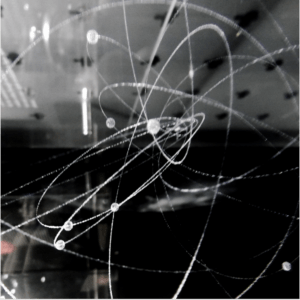17 year-old Sofia Radysh breaks down the complex science into a basic guide

October 24, 2012. Quantum state.
March 1, 2024
Key things you should know about quantum physics
Quantum physics is the study of energy and matter at the most fundamental level, which aims to uncover the nature of the building blocks of the world.
Fundamentally, quantum physics and quantum mechanics describe the movement of particles at atomic and subatomic levels. Although quantum mechanics is a very successful branch of physics that led to the development of modern technologies we use today, it can appear very complex.
The scientific theory is understood within the context of mathematical rules and principles. The key point is that everything in the universe has both particle and wave nature, at the same time. Harbingers Magazine have provided a basic guide to breaking down this world.
The history of quantum physics
Research into quantum physics developed around the 1900s when the existence of atoms was still unproven. In fact, some decided to refute the existence of atoms, which led Max Planck – a German physicist who was reluctant when it came to the atomic hypothesis – to discover that atoms do not release radiation continuously but rather in discrete multiples of a certain amount. What he discovered led him to accept atoms, but his findings took a bit more time to sink in.
Among the discoveries was the realisation that energy and matter can be thought of as small amounts or units of something – known as ‘quanta’ (singular: quantum), a portion of something.
Mathematician and physicist Albert Einstein went further and proposed that quanta are real and that radiation comes in discrete lumps of light energy, the quantum particle of light. One of Einstein’s major theories – the quantum theory of light – dates back to 1905. He argued that light is made up of small particles, known as photons, and these quantum particles have the ability to show wave-like properties. Although the quantum theory of light was not accepted for two decades, it is now considered a foundation for all modern physics.
What are some of the main concepts and theories in quantum physics?
Wave-particle duality:
Einstein’s theory came up against contradictory research with evidence suggesting that light is a wave. Thomas Young’s double-slit experiment, one of the most famous experiments in physics, is the key observation, proving that light diffracts (meaning that it breaks up and light propagates as waves). This experiment demonstrates that light and matter can display characteristics of both waves and particles.
This is explained in this well-known example. Imagine a wall with two slits in it and another wall behind it. If you throw balls at the wall, some will bounce right off while others will pass through the slits. Those that pass through the slits leave a mark on the wall behind. What will you see when a lot of them have passed through the two slits? Two strips of marks. The same thing happens with light.
When a beam of electrons or photons passes through two adjacent slits to hit a detector screen on the other side, they do not form clusters based on whether they passed through one slit or the other. Rather there’s a pattern of interference bands since they pass simultaneously through both slits.
As pointed out by Caltech, waves are inherently delocalised, meaning that they are ‘here and there’, whereas particles are localised. Einstein’s idea was that the complete description of light should take into consideration both its localised and delocalised properties.
Quantum superposition:
To understand one-electron interference, an explanation was suggested by physicist and mathematician Max Born. He claims that before an electron strikes the screen and the ‘dot’ is visible it has a probability of ‘being there, here and anywhere’. Quantum superposition is the probability of many states existing at the same time.
An individual electron cannot really be at different places at the same time, but it is true that it has the probability of being found in more than one place at a time.
Quantum physics in everyday life
Quantum mechanics led to several innovations, without which modern technologies would not exist. Max Born, in addition to teaching a new wave of physicists who made their own discoveries (including Schrödinger who developed the wave theory), also came up with the formulas of quantum mechanics.
These formulas allowed for further research and paved the way for a better understanding of the subatomic world. Born received the Nobel Prize for Physics in 1954 for his research.
Technologies based on quantum physics include lasers, developed by Theodore Maiman. Today, these are used in supermarkets to scan barcodes, making everyday shopping effortless, as well as in ground-breaking work in astronomy to help measure the distance to the moon.
Basically, all of modern technology relies on quantum physics. Phones, TVs, watches, vehicles, computers and a lot of other devices people use everyday only work because of our understanding of how electrons behave in ‘semiconductors’ – materials that are naturally insulating but can easily become conductors if a small electrical voltage is applied to them.
Quantum computing, despite struggling to find sufficient funding, has been the talk of the past few decades and with each passing year the dream seems closer. Quantum computers are still in their ‘infancy’, but they could help to solve complex issues such as climate change, develop new kinds of medicine, and create ultra-secure encryption.
Quantum computing is an industry that is very fast growing and will bring about significant change to the world.
What research is taking place in quantum physics?
The way the world works is constantly being studied and researched in quantum physics and the vast amount of subjects it involves, including the development of technologies, is ongoing.
One area of research is the fundamental interaction of gravity. Scientists at the University of Southampton are close to finding the way gravity works on a quantum level. Researchers have never fully understood how the force discovered by Newton worked at a subatomic level. The experiment used levitating magnets in order to discover the gravity in microscopic particles.
Researchers at Princeton University recently discovered an abrupt change in quantum behaviour while doing experiments with turning an insulator into a superconductor. This research could provide us with a further understanding of quantum mechanics in solid materials and take superconductivity – the ability to conduct a direct electrical current – in potentially new directions.




